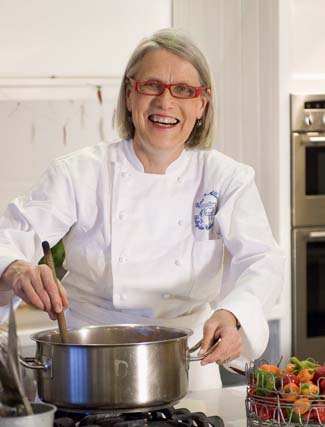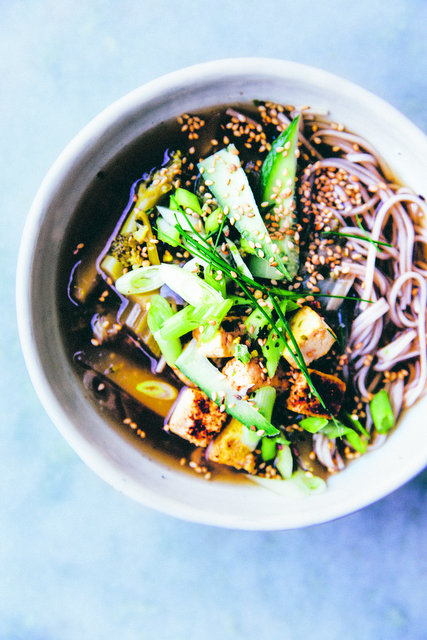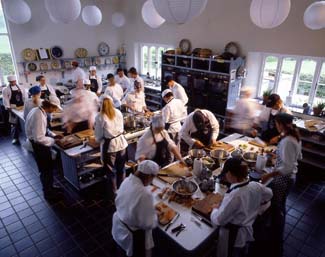The Darina Allen Column

This month Darina looks at the coming Food Trends for 2017 - What will we be eating in 2017?
Well for most of us it will probably be more of the same but my top tip for what it’s worth is to eat a wide variety of real food and no food products – real food is not the same as food products. We need lots of biodiversity to feed and nourish our gut biome – the health of our gut flora has a phenomenal impact on both our mental and physical health.
When I say real, I mean unprocessed, unpasteurised organic, chemical free, vegetables directly from our garden or from a real farmer or gardener in your local Farmers or Country Market.
Now, here’s a glimpse into trends and the food scene for 2017:
Flexitarian. There is a significant rise in the number of part time vegetarians – people who are reducing their meat consumption because of health, sustainability and animal welfare concerns. The rise and rise of vegan diets continues to confound the sceptics…
Free from…..everything….. Continues to gain market share even among those who do not have allergies or intolerances – the perception is that it’s healthier – this epidemic of faddism is dangerous for our health, the more we removed from our diet the less diversity we have in our systems.
Sports Nutrition is moving mainstream, energy balls, power drinks…. The virtuous triangle of great food, exercise and great sleep rings true. Bone broths are huge. Turmeric climbs and climbs, it contains curcumin, a super healthy compound, you see it in health sports drinks as well as food. Flavoured waters are exploding. Watermelon water is set to take over from coconut water in 2017. Kombucha, water and milk kefir and raw organic jersey milk and cream are virtually mainstream but there are increasingly bizarre flavours - birch water, cactus water - and then there are drinkable meals and regional cocktails.
Less Processed Food. Consumer demand for less processed foods is forcing companies to remove artificial ingredients and to reduce sugar and salt in their products. What was formerly alternative is moving towards main stream.
Rise and Rise of Online Shopping. Traffic chaos in towns and cities is fuelling the phenomenal increase in online shopping and home deliveries.
Organic, Antibiotic Free, Hormone Free, GM Free…. Demand is steadily rising as consumers become more aware and educated through the internet, media, films and Utube. Healthy Kids Meals is attracting a huge R & D budget as the obesity challenge deepens.
The Home Delivery Revolution – Meal Kits. Technology continues to play a greater role. Home delivery is well established in most major cities. The trend for ‘dining in’ instead of ‘dining out’ is beginning to cause concern to restaurateurs.
Meal Kits, with all the ingredients prepped in a box complete with step by step instructions for how to finish the dish at home, ticks all the boxes for busy commuters and parents who want the convenience and feel good factor without the hassle and waste. What’s not to like about that…. Drones may soon be delivering our meal kits and takeaway food….. Both Google and Virginia Tech are trialling this in the US.
Chefs getting more involved with farmers….Either buying or renting land themselves or partnering with farmers so they can use what is freshest and best in season and have the option to use all parts of the plant or animal. Artisan Butchery – house made charcuterie; chefs are using more unsung cuts of meat and experimenting with grass fed jerky, seafood jerky, pickles, artisan condiments Fermented foods will get even bigger. Fine dining continues to lose out to casual neighbourhood places doing edgy reasonably priced food.
Clean labels. In response to growing consumer unease, food manufactures are scrambling to produce simpler products with fewer, more natural sounding ingredients and greater transparency. The clean food frenzy is also running out of puff and credibility. Low fat, carbohydrates and sugar rich foods are the villains of 2016 and 2017.
Plant Proteins. Perhaps the strongest food trend of all, not just vegetables but also expect to see more and more fungi and algae. (low cal, high in nutrients). Yoghurt with vegetables of course. Brussel Sprouts are having their moment; move over kale; beets are all the rage – the flavour of 2017. Kaleina, a mini version of kale, and swede turnip chips are already with us. Meat and fish substitutes abound. A veggie burger that bleeds launched in 2016 is only the beginning. The term ‘plant butcher’ has already been coined according to the sustainable food focused media.
Insect Protein. Bugs will be the next big thing in protein. I’ve seen this coming for a number of years now; I’ve eaten ants in Copenhagen. Grasshoppers in Mexico and Tarantulas in Loas but, despite the convincing nutritional arguments, I can’t see it coming ‘main stream’ in this decade.
The sous wide craze is waning at last (cooking food in a plastic bag in a temperature controlled water bath). Have to say, I was never convinced and am so delighted to see this particular practice slipping out of favour in favour of cooking over fire.
Cooking over Fire. We can’t get enough of charred, blackened, torched and smoked food not just fish but meat, vegetables, drinks, even cordials and cocktails……
Souping is the new juicing….I did wonder about that craze, surprise, surprise! turns out that soup contains the fibre, seeds, rind and pulp that juicing often discards.
Hot, Hotter, Hottest……our appetite for heat continues, chillies and ever hotter sauces, Sri Racha is now virtually looked on as a sauce for wimps but we are also loving and having fun with Shichimi ogarashi from Japan. Sweet and spicy, Gochujang from Korea, Sambal Oelek from Indonesia, Harrissa from North Africa, Tsire, a spice mixture from West Africa, Zhoug a Yemeni green chilli sauce and spicy Berbere from Ethiopia….
Heirloom varieties beyond Tomatoes, Apples and Potatoes…Ancient grains, chilis and pulses, Kamut, Einkorn, Teff from Ethopia, Amaranth the ancient grain of the Aztec, Sorghum is the new quinoa. Sorghum is an ancient cereal grain and is used for food, fodder and the production of alcoholic beverages. It is regarded as the fifth most important cereal crop grown in the world. Some of the health benefits of sorghum include its ability to prevent certain types of cancer, help control diabetes, improve digestive health. And who knew that porridge would become so cool, we’ll see porridge served at breakfast, lunch and any time in between with sweet and savoury toppings.
Food Trucks and Shacks. Street inspired foods – authentic ethnic both in cafés, restaurants and in food truck, pierogi, boa buns, multi ethnic dumplings, Japanese crepes - Okonomi yaki.
Sprouting Seeds (I remember that well) is predicted to be another strong food trend. Not just seeds but nuts, beans and grains. This hugely increases the nutritional value and creates enzymes that make plant proteins, essential fatty acids, starches and vitamins more available to the body.
Bowl Food, another hot trend. We love serving food in bowls everything from ramen to noodles, pasta, curries, conghee, tagines, rendang….. Check out Bowls of Goodness by Nina Olsson published by Kyle Books
Build your own Pizza. Pizzerias are inviting customers to build their own pizza from a range of toppings laid out like a salad bar. Can certainly see the appeal of this….
Quest for less Familiar Flavours. Expect to see more Eastern European food, Georgian, Middle Eastern, African flavours particularly Ethiopian….Poke pronounced po-kay is sweeping across the US, cubed fish or shellfish often yellow fin tuna or octopus with soy sauce, cucumber, spring onions, sesame oil served over rice. The taco craze continues unabated for 2017.
So there you have it and a few of the hot trends for 2017 but there’s much much more….
RECIPES:

Nina Olsson’s Bowl of Miso Happy Soup
Miso soup with ginger, tofu, soba noodles and shiitake mushrooms
This easy-to-make soup is the perfect, light comfort food all year around. Miso is a big deal in Japan where it’s a staple of daily life. The uses for it are endless and its rich flavour makes it a great addition to any kitchen.
Miso paste is made from fermented soya beans and is available in different varieties – lighter miso is milder in taste and has been fermented for less time than the darker variety.
Miso soup is popular for fasting and weight loss as it contains very few calories. It’s also a perfect restorative soup when you want to recharge with something light. This recipe delivers the lightness of miso soup while adding a little extra texture and flavour.
Serves 4
Dashi (Makes 1 litre)
1 strip of kombu seaweed
1 litre water
Miso Soup
250g soba noodles
drizzle of rapeseed oil
75g shiitake mushrooms
150g firm tofu, cut into small cubes
salt
few pinches of shichimi togarashi or chilli flakes
1 tablespoon grated fresh ginger
2 tablespoons shoyu
75g broccolini or broccoli florets
75g miso paste (I use white or yellow)
1 tablespoon lime juice
drizzle of sesame oil
Toppings (Optional)
cucumber, cut in thin sticks
2 spring onions, thinly sliced
handful of sesame seeds
handful of fresh herbs (chives or coriander fit perfectly)
To make the dashi, soak the kombu in the water overnight in the fridge, or for a minimum of 1 hour. Transfer to a large saucepan, bring to a simmer then remove the kombu. Strain the liquid through a sieve and store in the fridge until ready to use.
Cook the soba noodles according to the packet instructions. Rinse in cold water and drain.
Heat a frying pan over a medium–high heat and add a drizzle of rapeseed oil. Stir-fry the shiitake mushrooms over a medium-high heat for a couple of minutes then remove from the pan. Clean the pan and add another drizzle of rapeseed oil, then stir-fry the tofu cubes until golden and sprinkle with salt and a little shichimi togarashi. Remove from the heat.
Bring the dashi to the boil in a soup pot, then reduce the heat to a simmer.
Add the ginger, shoyu, mushrooms and broccolini and simmer for 10 minutes, then remove from the heat.
Separate 200ml of the dashi broth and dissolve the miso in it. Pour the concentrated miso dashi back into the pot with the rest of the dashi and add the lime juice and sesame oil. Taste and adjust the flavour with additional miso paste, if needed.
Pour the miso soup into four bowls then add the tofu cubes and soba noodles. Top with cucumber, spring onions and sesame seeds, chives
or coriander.
Taken from Nina Olsson’s Bowls of Goodness
Watermelon Lemonade
4 ozs (110 g/½ cup) sugar
4 fl oz (110 ml/½ cup) water
600 g (20 ozs/4 cups) cubed watermelon
675 ml (24 fl ozs/3 cups) cold water
110 ml (4 fl oz/½ cup) fresh lemon juice
Place the watermelon into a blender. Cover and puree until smooth, then strain through a fine mesh sieve.
Next bring the sugar and water to a boil in a saucepan over a medium heat until the sugar dissolves, about 5 minutes. Remove from the heat. Stir in the cold water and lemon juice.
Put lots of ice cubes into 12 glasses, scoop 2 or 3 tablespoons of watermelon puree over the ice, then top with the lemonade. Gently stir before serving.
---
The Food and Drinks Festival at Ballymaloe is a weekend filled with fascinating facts, inspirational stories, intriguing discussions, incredible knowledge, fantastic music, fabulous dancing and of course, delicious food and drinks. It is the only festival of its kind in Ireland and has created an important hub for food and drinks enthusiasts worldwide to meet and share ideas with each other. And it’s a new look LitFest this year, so – get booking!
---
'30 Years at Ballymaloe' - Bord Gáis Avonmore Cookbook of the Year 2013
Good Food Ireland Cookery School of the Year 2012/2013
***
 Once again, the Ballymaloe Cookery School in East Cork has a great programme of cookery courses for all interests and abilities running throughout 2017. Ranging from a relaxing visit to sit in on an afternoon cookery demonstration to a week long ‘Intensive Introductory Course’.
Once again, the Ballymaloe Cookery School in East Cork has a great programme of cookery courses for all interests and abilities running throughout 2017. Ranging from a relaxing visit to sit in on an afternoon cookery demonstration to a week long ‘Intensive Introductory Course’.
Sitting in the middle of a 100 acre organic farm the Ballymaloe Cookery School provides its students not only with a life skill learnt under the expert tutelage of their very capable teachers but also a place to relax and unwind from the stresses and strains of normal everyday life. The cottage accommodation available onsite for residential courses consists of a collection of delightful converted outbuildings which have been transformed over the years by the Allens, and other accommodation is available locally for the short courses.
www.cookingisfun.ie






There are currently no comments
Leave a comment
Not a member? Register for your free membership now!
Or leave a comment by logging in with: